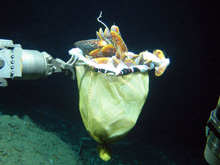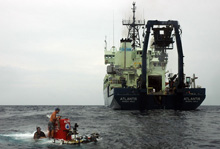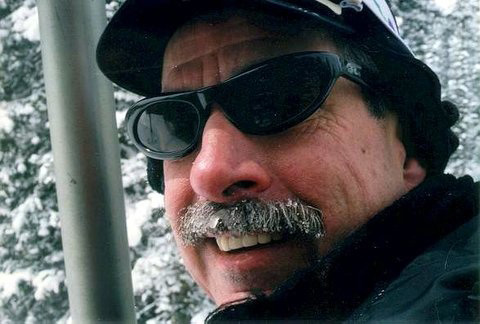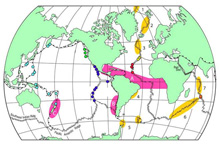
This map of the world's oceans shows target areas for Biogeography of Chemosynthetic Ecosystems research. Area A (in pink) includes the Equatorial Atlantic Belt region, extending from the seeps off Costa Rica, through the Gulf of Mexico and Caribbean, and across the Atlantic to western Africa. Click image for larger view and image credit.
Deep submergence vehicle (DSV) Alvin pilot Gavin Eppard snagged this heaping scoop of mussels at Atwater Valley 340. Click image for larger view and image credit.
ChEss Strategy
June 1, 2006
Jeremy Potter
NOAA Ocean Exploration
26° 21.28 N
094° 29.86 W
Despite almost 30 years of exploring and researching chemosynthetic communities, scientists still have many more questions than answers.
- Where are chemosynthetic habitats located?
- What is the diversity of animals living in these exotic communities?
- How do these species interact with each other and with their environment?
- How are chemosynthetic communities in different parts of the world’s ocean connected?
- How do physical and biological processes facilitate or hamper these connections?
These are just a few of the key questions remaining about these remarkable deep-sea habitats.
Scientists eager to jumpstart efforts to solve many of these deep-sea riddles work together in the international Census of Marine Life (CoML) ChEss program. ChEss stands for Biogeography of Deep-Water Chemosynthetic Ecosystems, and it is one of several programs affiliated with CoML. ChEss acts as an umbrella program, providing a large-scale overview to the exploration and research being conducted at sea and in labs throughout the various ChEss partner-nations. Through coordinated efforts, ChEss scientists aim to ensure maximum return from the research for the benefit of the community as a whole. Our expedition’s science party includes members of the ChEss program steering committee and representatives from the U.S., Austria, France, and Germany.
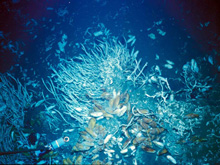
The tubeworm Escarpia spicata and the seep community at 1,900 m on the Jaco Scarp off of Costa Rica. Although on the Pacific side of the Isthmus of Panama, this community shares some similarities with those found at the seeps in the Gulf of Mexico, Caribbean, and Atlantic. This picture was taken during the Meteor cruise 54. Click image for larger view and image credit.

This sample of a seep community off the western coast of Africa was taken with a box corer. Even though this community is on the opposite side of the Atlantic from the Gulf of Mexico, it bears a striking resemblance to the seep communities that we are currently studying. Click image for larger view and image credit.
In 2003, ChEss scientists established a hierarchy of target study areas. A top-priority target is the Equatorial Atlantic Belt region, where there are many known locations of chemosynthetic communities. The belt extends east-to-west, along a longitudinal gradient, from the Gulf of Mexico and the Caribbean across the hot vents of the mid-Atlantic ridge, to the continental margin of West Africa. Understanding the wide diversity of sites and fauna of the Gulf of Mexico seeps is key to understanding the relations among the many chemoautotrophic communities of the Equatorial Atlantic Belt.
The primary purpose of our cruise is to examine the biodiversity and ecology of diverse cold-seep habitats deeper than 1,000 m on the Gulf of Mexico slope. Information from this cruise will prove vital on a number scales. We have certainly added to our understanding of Gulf of Mexico seeps. But, when considered along with results from other ChEss expedition to areas like the mid-Atlantic Ridge, Barbados, and the west coast of Africa, scientists will be one step closer to answering some of the larger questions about worldwide chemosynthetic community ecology and biogeography.
Final safety checks are carefully run through before the deep submergence vehicle (DSV) Alvin descends to the sea floor. The research vessel (R/V) Atlantis and the DSV Alvin crew often spend eight months per year at-sea. Click image for larger view and image credit.
Far From Home
June 1, 2006
Jeremy Potter
NOAA Ocean Exploration
Dear Big Jake:
How’s everything back home in Wild Wonderful West Virginia? We’re now in the home stretch of the 28-day cruise. We’ve had an amazingly successfully cruise over the past 27 days. We have discovered new species, found new habitats, visited sites that no human has ever seen, and gotten a good start on answering some of the most fundamental questions about the communities on the sea floor in the deep Gulf of Mexico.
As soon as the deep submergence vessel (DSV) Alvin is back on deck after today’s dive, the captain will point the research vessel (R/V) Atlantis in the direction of Galveston, Texas, and head for shore. Between working up the samples from the last dive and then packing everything away, the science party will probably have its hands full. I’m sure that most of us will be drinking copious amounts of coffee into the early morning hours. I doubt anyone will have much sleep tonight
This cruise has been a much different personal experience for me than any previous ones. In the past, 28 days away from friends and family wouldn’t have been particularly difficult for me. I’ve been away for much longer periods of time before. In the last month, I missed younger brother Dave’s medical school graduation. More important than the graduation ceremony, I missed the party! I missed Mother’s Day and Memorial Day. I also missed your 62nd birthday. I’ve missed lots of events like those before and not given them much of a second thought. This time was different. I’m sorry that I can’t be with you in the hospital today.
Sporadic e-mail and a static-laden phone call just don’t cut it. Despite the technological advances that allow us to keep in touch with friends and family while we’re at-sea, it’s still difficult. There’s a definite sense of helplessness knowing that there is no quick and easy way to get back home if you’re needed. I’ve noticed that most people onboard the ship don’t talk a whole lot about home. I’m sure that everyone thinks about home. People mention home and their families all the time, but you don’t hear many in-depth conversations about it. It’s almost like it’s a taboo topic, something that is better to ignore because you know you can’t go home even if you wanted to.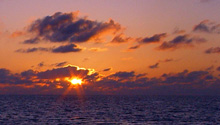
Calm seas and a beautiful sunrise greet the R/V Atlantis in the Gulf of Mexico. Click image for larger view and image credit.
Perhaps that’s why everyone onboard tries to stay so busy. Staying busy helps pass the time quicker. Between keeping the ship running, launching and recovering equipment, and processing samples everyone has something important to do.
When I haven’t been working I’ve found my thoughts drifting back to family. I’ve thought a lot about you and what I’ve learned from you over the years. I realized that it will be 11 years ago August, when I told you how nervous I was about starting my first job after college, working on the crab boats on Alaska. When I expressed my hesitations I expected a concerned and compassionate response. What I got was five-word retort that I’d be fired for repeating. You essentially told me "deal with it. " Well, it may not have been what I expected, but it’s exactly what I needed to hear then. I loved my time in Alaska! In the past 11 years, I’ve gone from working on one of the smallest and most grimy crab catcher boats in the Bering Sea fleet to having the opportunity to spend a month on one of the premier research vessels on the globe. I owe you a huge thanks for helping me get here. . . and through all the stuff that’s happened in between!! There’s been plenty!
Well, Big Jake, I hope today goes smoothly for you. I want you to know that no matter where I am, you’re on my mind and in my heart. I’ve got to run and get back to work. After all, I still have a whole lot of work ahead of me before we finish out here. It’s been a wonderful and exciting cruise for all of us. It’s been particularly educational for me. But it’s getting to that time when many of us are thinking about coming home!
See ya’ on Saturday!
The Jerm
Jake, aka Granddad Stache, enjoys a brief respite from skiing with the family. Click image for larger view and image credit.
Sign up for the Ocean Explorer E-mail Update List.





























